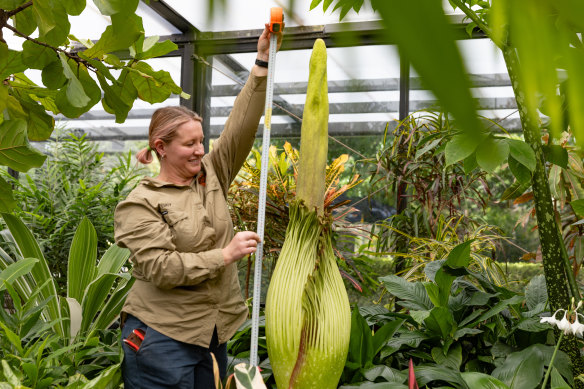By Liam Mannix
To see the corpse flower is to witness the powerful majesty – and daft absurdity – of nature.
The corpse flower emerged on Tuesday in the glass-walled conservatory of Geelong’s Botanic Gardens. It is getting taller, and it is getting hotter.
In the coming days, it will reach almost 40 degrees and then – no one knows quite when – the flower will open.

Lucy Griffiths, nursery horticulturist at Geelong Botanic Gardens, measures the flower on Thursday morning.Credit: Jason South
It will emit a scent – think rotten cabbage or dead possum – that you’ll probably be able to smell a couple of kilometres away.
The corpse flower has been building up to this moment, stockpiling energy, for a decade.
The process will happen for two gloriously disgusting days. And then the flower will die, and the plant will retreat underground for another 10 years.
People are flocking to see it, even booking hotels in Geelong as they wait for the revelation.
Some see something sacred. “It’s just the intricacy of creation – that’s so powerful,” says Ruth, who wears a small silver cross and declines to give her surname.
“Even the name is quite prophetic,” says Diane Spicer. Death and rebirth, she says. The passing of the seasons. “That’s the way God speaks to me.”
For others, the experience is more profane.
It looks like “something rude”, says Kim Newham.
“Genitals,” observes her daughter, Kim, filling in the gap. “But that’s Mother Nature, right?”
In the wild, corpse plants – Amorphophallus titanum – grow only in tropical Sumatra and Java in Indonesia, where they are endangered by palm oil plantations, poachers and their steadfast refusal to reproduce in a sensible manner.

The corpse flower is due to open any day.Credit: Jason South
To spread their pollen, corpse flowers seek not bees but carrion flies and beetles, which typically feed or lay their eggs on rotten flesh. To draw them, the plant engages in mimesis: its smell resembles a dead animal, its flowers are the deep red of congealed blood.
Its scent comes from a suite of volatile molecules, including dimethyl disulfide (garlic), dimethyl trisulfide (rotten flesh), methyl thioacetate (sulfur) and isovaleric acid (cheese or sweat).
It smells like “dead rat, dead possum” mixed with “rotten cheese and fermenting cabbage”, says Matt Coulter, horticultural curator and corpse flower expert at the Botanic Gardens of South Australia,
Over seven to 10 years, the plant builds an enormous underground root – known as a corm – which looks like a huge sweet potato and can be as heavy as 150 kilograms. Geelong’s corpse flower is young and weighs just 10 kilograms.
This stored energy is then used to produce a huge flower.
Staff at the Geelong gardens have been monitoring its growth – about 10 centimetres a day, now slowing – and temperature.
When it is ready, the tightly wrapped leaves, or spathe, will open to reveal hundreds of small flowers at the base of the spadix – the central pillar.
The heat of the spadix drags the scent up from the base and then pushes it out in putrid pulses, attracting any nearby insects to lay their eggs in the rotting “flesh”. The plant can get so hot it starts steaming.
“The insects are running around, trying to find the best place to lay their eggs, and while they do that they are running around all over the male and female parts of the flowers,” says Geelong gardens co-ordinator Kellee Reissinger.
They will leave disappointed – but covered in the plant’s pollen. If this were Sumatra, they would hopefully encounter another corpse flower to spread it.
Many plants can self-pollinate, sharing pollen between male and female flowers on the same plant.
Not the corpse flower: the female flowers are receptive for 24 hours, then it is the male flowers’ turn. If it does not get pollinated, the whole structure then collapses within a week.
The Geelong gardens have set up three time-lapse cameras around the plant and a live-stream – though several attendees on Thursday seemed to be there largely to wave to friends on the other end of the video.
While many gardening fans are here, it’s brought new people in as well. Maddie Crothers, 23, has already come twice, hoping to see it bloom.
She’s planning a third trip, to her surprise. “I’m too committed now,” she says with a laugh. “I would have not cared much about plants – but here’s my second visit.”
Visitors have been coming since early in the morning, and numbers will continue to build.
“It hits humans’ need to see everything big,” says Reissinger. “We love megafauna, we love big bridges. It makes us feel small.”